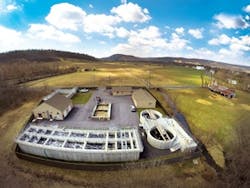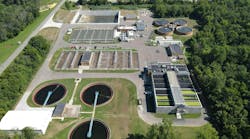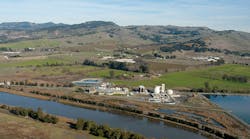The Fairfield Municipal Authority (FMA) provides water and sewer services to the borough of Fairfield and two portions of Hamiltonban Township in southern Pennsylvania. The region has a rich history, especially during the Civil War, when several historic battles were fought in the vicinity. Today, the service area is mostly agricultural.
History of Improvements
The original FMA Wastewater Treatment Plant was built in 1967 as a 70,000-gal-per-day (gpd) extended aeration activated sludge plant. Following a 1977 feasibility study, the plant was expanded to accommodate population growth and provide service to a new industrial facility. Capacity was increased to 150,000 gpd and the plant became a two-stage carbonaceous/nitrification activated sludge plant.
In 2006, a new residential development prompted the need for additional sewage treatment for 496 new homes in the service area. Rather than construct a new facility, upgrades were planned to increase the existing facility’s capacity to 300,000 gpd, as well as add treatment processes to help the facility comply with Chesapeake Bay standards.
Because the plant is located in the Chesapeake Bay Watershed, its effluent must meet the strict limits set by the U.S. Environmental Protection Agency and the Pennsylvania Department of Environmental Protection (DEP). Chesapeake Bay standards require enhanced nutrient removal with limits on total nitrogen (TN) and total phosphorus (TP) in effluent discharged into the bay.
Plans were set in motion in 2003 to complete an upgrade to meet Chesapeake Bay standards, which include less than 20 mg/L biochemical oxygen demand (BOD); less than 20 mg/L total suspended solids (TSS); less than 8 mg/L TN; less than 1.5 mg/L ammonia; less than 1 mg/L TP; and discharging less than 7,306 lb of TN and 974 lb of TP annually. In 2005, lack of a funding source halted the project and caused it to remain inactive for a number of years.
In the fall of 2010, FMA secured funding and began pursuing the upgrade for enhanced nutrient removal at the facility. Civil engineering firm C.S. Davidson Inc. was chosen to provide design and engineering services for the new facility, and construction firm TAH won the bid to construct it. The new system became operational in October 2012.
Today, the plant contains a dual-train concrete containment Aquapoint AquaCELL moving bed biofilm reactor (MBBR) with pre- and post-anoxic zones to ensure nitrification and denitrification of the influent waste. The infrastructure consists of primary screening and grit removal, flow equalization tank, pre-anoxic MBBRs, three-stage aerobic MBBRs, recycle chambers, post-anoxic MBBRs, re-aeration zones, secondary clarifiers, ultraviolet disinfection, aerobic sludge digestion chambers and chemical feed systems.
The process incorporates AquaCELL 466 biofilm carrier media, which moves freely within an aerated wastewater treatment process. As the carrier elements migrate throughout the water column, wastewater passes through the protected internal cells allowing contact between organic and inorganic waste and the fixed biofilm, which provides treatment.
The plant now is able to meet the effluent standards set by DEP, reporting an average of 6 mg/L BOD, 6.7 mg/L TSS, 0.4 mg/L ammonia, 6.1 mg/L TN and 1.2 mg/L TP.
Managing Expectations
“As is typical of many treatment plants, we constantly deal with inflow and infiltration issues,” said Mark Keller, treatment plant operator for FMA. ”This upgrade has definitely made it easier to adjust to high flows.”
The plant periodically experiences high-flow precipitation events with flows exceeding 600,000 gpd. The system’s fixed-film process and 250,000 gal of equalization capacity help alleviate this added stress on the system while maintaining compliance.
Although the population of the service area is not expected to grow significantly in the near future, the plant is prepared to handle increased daily flows through the addition of the carrier media that provides high specific surface area for biofilm growth.
“The system has been performing extremely well since the upgrade. We have been able to meet our total phosphorus and total nitrogen requirements with little chemical addition,” Keller said. “The process is very operator friendly and the support from Aquapoint has been great.”
Download: Here


